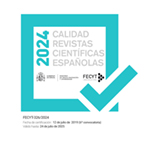From Ptolemy to Hering: binocular perception
Abstract
Euclid proposed to trace pyramids (or cones) as artifacts to facilitate the study of visual perception. The artifact assumes that the object seen delimits the base of a pyramid at the apex of which is the perceived eye. The artifact faces a serious difficulty when we notice that visual perception is carried out with two cooperating eyes. The article discusses two attempts to modify the Euclidean artifact to make it work without giving up the central assumptions. These attempts correspond to the classical studies of Ptolemy’s binocular vision and Ewald Hering’s contributions in the 19th century.
Downloads
Article download
License
In order to support the global exchange of knowledge, the journal Anales del Seminario de Historia de la Filosofia is allowing unrestricted access to its content as from its publication in this electronic edition, and as such it is an open-access journal. The originals published in this journal are the property of the Complutense University of Madrid and any reproduction thereof in full or in part must cite the source. All content is distributed under a Creative Commons Attribution 4.0 use and distribution licence (CC BY 4.0). This circumstance must be expressly stated in these terms where necessary. You can view the summary and the complete legal text of the licence.












